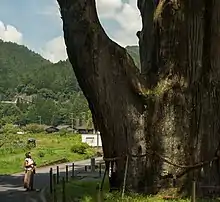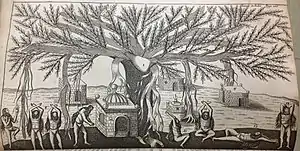Sacred tree
A sacred tree or holy tree is a tree which is considered to be sacred, or worthy of spiritual respect or reverence. Such trees appear throughout world history in various cultures including the ancient Hindu mythology, Greek, Celtic and Germanic mythologies. They also continue to hold profound meaning in contemporary culture in places like Japan (shinboku), Korea (dangsan namu), India (bodhi tree), and the Philippines, among others. Tree worship is core part of religions which include aspects of animism as core elements of their belief, which is the eco-friendly belief that trees, forests, rivers, mountains, etc have a life force ('anime' i.e. alive) and need to be conserved and used in a sustainable manner.


An example of the continued importance of sacred trees in contemporary urban culture is the 700-year old camphor growing in the middle of Kayashima Station. Locals protested against moving the tree when the railway station had to be expanded, so the station was built around it.[1] The sacred Banyan tree is the national tree of India, and the Bodhi Tree under which the Buddha is said to have meditated in Bodh Gaya, is also revered as sacred.
Sacred trees are some times planted in the sacred groves, which can also have other type of trees too.[2]
Sacred trees in mythology
Trees in mythology are the trees that appear in the folklore genre of myth.
Sacred trees and plants by religion and regions
Celtic
Germanic
Serbian
Zapis are the sacred tree in Serbian tradition.
Christianity
Many trees, groves and gardens are considered sacred inside Christianity. Also many Christians adopted the practise of venerating Evergreen trees for winter festivals in December. This was a common practice due to the belief that Evergreens have long lives and would be cut down and decorated. Eventually this practice became apart of the Christmas festival of Christianity. Most notably the Gethsemane, the location where Jesus was betrayed by Judas Iscariot (agony in the Garden) according to the bible. The garden thereby became a common pilgrimage site.[3] Saints associated with specific trees and locations also became pilgrimage sites in early Chirstanity.[4][5]
Indic religions


In the Dharmic (Indian-origin) religions, such as Hinduism, Buddhism, Jainism and Sikhism, the ecology, such as trees, rivers, fauna, and mountains, is sacred and revered objects of worship. There are numerous sacred groves of India. In Hindu belief, the Kalpavriksha is a wish granting tree. In addition to the Panchvati trees described below, other sacred trees include species such as the Akshayavat (sacred fig tree), Banana leaf, Kadamba, Parijata, and Sandalwood. The Bodhi Tree (banyan) is specially revered, and there are numerous large banyan trees in India. Matsya Purana, a Hindu text, has a Sanskrit language shloka (hymn), which explains the importance of reverence of ecology in Hinduism. It states, "A pond equals ten wells, a reservoir equals ten ponds, while a son equals ten reservoirs, and a tree equals ten sons."[6]
Triveni groves
Triveni is a grove of 3 specific trees sacred to Indian-origin religions (Hinduism, Buddhism and Jainism), which are the vata (ficus indicus, banyan), ashvattha (ficus religiosa, Peepal) and Nimba (azadirachta indica, neem).
Panchavati groves

Panchavati, are groves of five trees sacred to Indian-origin religions, such as Hinduism, Buddhism and Jainism. Panchavati has five types of sacred trees, however there are more than five types of trees which are considered sacred and form the part of panchavati. Sacred trees used in panchavati are the Vata (ficus benghalensis, Banyan), Ashvattha (ficus religiosa, Peepal), Bilva (aegle marmelos, Bengal Quince), Amalaki (phyllanthus emblica, Indian Gooseberry, Amla), Ashoka (Saraca asoca, Ashok), Udumbara (ficus racemosa, Cluster Fig, Gular), Nimba (Azadirachta indica, Neem) and Shami (prosopis spicigera, Indian Mesquite).[7][8]
Forests Department, Haryana has initiated a state-wide program to plant panchavati groves in each village, which will be planted along the temples, ponds, and common land. From 2021, land was identified in villages for planting these groves which will be looked after by the villagers. Within each grove, peepal will be planted in the east, banyan in the north, bel in the centre, amla in the west and ashoka tree in the south.[8]
Sacred plants
The sacred fruits and plants include the Bael, Kusha grass, Tulasi (see Tulasi chaura and Tulasi Vivaha), flowers such as Lotus, Champaka, coconut, paan (betal leaf), banana leaf, etc are also sacred. Tulsi in India is cultivated for religious and traditional medicine purposes, and also for its essential oil. It is widely used as a herbal tea, commonly used in Ayurveda, and has a place within the Vaishnava tradition of Hinduism, in which devotees perform worship involving holy basil plants or leaves. The sacred flowers include the Lotus, Champaka and Marigold.
Japan

Sacred trees, called shinboku, are a deeply ingrained part of a Japanese culture that has historically viewed itself as being united with nature, rather than separate from nature; thus, recognizing the sacredness of trees, stones, mountains, forests, and the elements has been a relatively constant theme in Japanese culture for thousands of years.[9][10] In the present day Japan, shinboku are trees inhabited by kami (spirits or deities) and can readily be found in many of the 100,000 Shinto shrines existing in throughout the country.[11] Although any tree can technically become a shinboku through a Shinto ritual process of inviting a kami to inhabit it, most shinboku are particularly large or aesthetically interesting examples of endemic species such as camphor, ginkgo, or Japanese cedar. The oldest shinboku are estimated to be several thousands years in age. Because shinboku are viewed as being literal sanctuaries, inhabited by kami, they are protected as a physical and spiritual embodiment of the divine nature. In most cases, Shinboku can be easily identified by the straw or hemp rope called a shimenawa which is typically wrapped around the tree; the rope acts as both a sign of the tree's sacredness, and also as a protective barrier between the spirit world and the human world.[12]
In addition to individual shinboku, shrines and Buddhist temples are often surrounded by sacred forests called Chinju no Mori, which are considered sacred forests where kami, including spirits of ancestors, dwell.[10]
Korea

In Korea, species such as Zelkova serrata, Pinus koraiensis, and Ginkgo biloba, have been considered a symbol of protection for villages since ancient times, and can still be found planted at central points in cities, towns and villages around the country.[13] The trees, referred to as dangsan namu (god tree) often stand next to small pavilions, serving both as shaded informal gathering points, and spaces for traditional rituals and ceremonies involving prayer and offerings to the tree.[14] The oldest of these trees are estimated to be in excess of 1,000 years in age, and are protected as natural monuments by Korean law.[15]
In 2013, the Korea Forest Research Institute announced a project to clone the sacred zelkova, pine, and ginkgo trees that are identified as natural monuments, so their lineage will not be lost in case of disaster or death due to age.[16]
Philippines
Bathala, the indigenous religious beliefs of the Philippines practiced in pre-colonial Philippines, is a mix of Hindu-Buddhist and native belief in spirits such as anitos. Indigenous Philippine shrines and sacred grounds host the sacred trees.
.
Gallery

.jpg.webp) A train station was built around the sacred camphor tree at Kayashima Station in Japan
A train station was built around the sacred camphor tree at Kayashima Station in Japan A painting by Rab-i-Rashidi dating to 1314 CE, depicting the sacred tree of Buddha
A painting by Rab-i-Rashidi dating to 1314 CE, depicting the sacred tree of Buddha A 1782 drawing of "The Sacred Hindoo Grove near Chandod on the Banks of the Nerbudda" in Bombay, India
A 1782 drawing of "The Sacred Hindoo Grove near Chandod on the Banks of the Nerbudda" in Bombay, India_(B).jpg.webp) A sacred camphor tree in Kawazu, Shizuoka Prefecture, Japan
A sacred camphor tree in Kawazu, Shizuoka Prefecture, Japan Sacred Photinia serrulata tree at Miyajidake Shrine in Fukutsu, Fukuoka, Japan
Sacred Photinia serrulata tree at Miyajidake Shrine in Fukutsu, Fukuoka, Japan Sacred forest at Miyajidake Shrine in Fukuoka, Japan
Sacred forest at Miyajidake Shrine in Fukuoka, Japan A sacred ginkgo at Nyusakado Shrine in Wakayama, Japan
A sacred ginkgo at Nyusakado Shrine in Wakayama, Japan
 Indian men performing yoga asana under a Banyan tree (1688)
Indian men performing yoga asana under a Banyan tree (1688)
References
- "Japanese Train Station Protectively Built Around a 700-Year-Old Tree". 27 January 2017.
- Cusack 2011, pp. 171–172.
- Halevi, Masha (November 10, 2015). "CONTESTED HERITAGE: MULTI-LAYERED POLITICS AND THE FORMATION OF THE SACRED SPACE – THE CHURCH OF GETHSEMANE AS A CASE-STUDY". The Historical Journal. 58 (4): 1031–1058. doi:10.1017/S0018246X14000776. S2CID 157552007 – via www.academia.edu.
- Gay, David Elton (November 10, 2004). Roper, Jonathan (ed.). Charms and Charming in Europe. Palgrave Macmillan UK. pp. 32–46. doi:10.1057/9780230524316_3 – via Springer Link.
- Hahn, Cynthia (January 1, 2010). "What Do Reliquaries Do for Relics?". Numen. 57 (3–4): 284–316. doi:10.1163/156852710X501324 – via brill.com.
- Haryana mulls giving marks to class 12 students for planting trees, Hindustan Times, 26 July 2021.
- Panchvati trees, greenmesg.org, accessed 26 July 2021.
- Peepal for east amla for west, Times of India, 26 July 2021.
- Picken, Stuart D. B. (1980). Shinto : Japan's spiritual roots. Edwin O. Reischauer (First ed.). Tokyo: Kodansha International Ltd. ISBN 0-87011-410-7. OCLC 6355590.
- Senda, M. (1992). "Japan's Traditional View of Nature and Interpretation of Landscape". GeoJournal. 26 (2): 129–134. doi:10.1007/BF00241206. ISSN 0343-2521. JSTOR 41145343. S2CID 140180161.
- Sato, Akira (1964). "Rural Landscape in Japan". Ekistics. 18 (109): 460–461. ISSN 0013-2942. JSTOR 43614121.
- "Shinto Symbols (Continued)". Contemporary Religions in Japan. 7 (2): 89–142. 1966. ISSN 0010-7557. JSTOR 30232989.
- "천연기념물 대전 괴곡동 느티나무 (大田 槐谷洞 느티나무) : 국가문화유산포털 - 문화재청". Heritage Portal : CULTURAL HERITAGE ADMINISTRATION (in Korean). Retrieved 2021-08-14.
- "느티나무 - 한국민족문화대백과사전". encykorea.aks.ac.kr. Retrieved 2021-08-14.
- "천연기념물 삼척 도계리 긴잎느티나무 (三陟 道溪里 긴잎느티나무) : 국가문화유산포털 - 문화재청". Heritage Portal : CULTURAL HERITAGE ADMINISTRATION (in Korean). Retrieved 2021-08-14.
- Service (KOCIS), Korean Culture and Information. "Ancient trees to be cloned : Korea.net : The official website of the Republic of Korea". www.korea.net. Retrieved 2021-08-14.
Further reading
- Cusack, Carole M. (2011). The Sacred Tree: Ancient and Medieval Manifestations. Newcastle upon Tyne: Cambridge Scholars Publishing. ISBN 9781443830317.
- Hunt, Ailsa (2016). Reviving Roman Religion: Sacred Trees in the Roman World. Cambridge Classical Studies. Cambridge: Cambridge University Press. doi:10.1017/CBO9781316597859. ISBN 9781107153547.